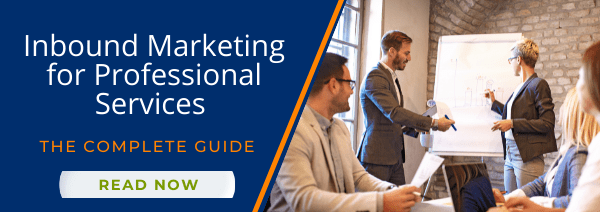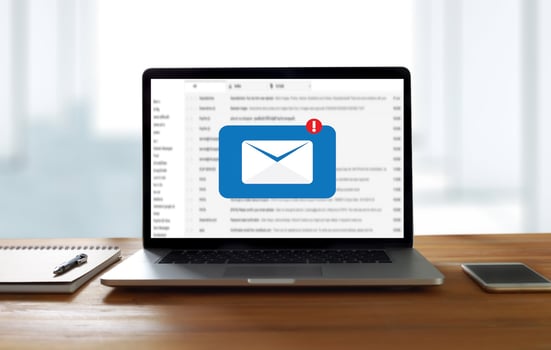Referral leads – all professional services companies want them; very few of them can easily get them. No matter what marketing activities our clients in the services arena undertake, they all report referrals as the best type of lead they can obtain. Why? Referrals are typically acquired at a lower cost while also being more sales qualified than your standard digital or traditional lead. After all, your firm's clients are out there attending conferences, networking, and meeting other businesses with needs similar to their own. So why not leverage them as a lead generation resource?
But attracting referral leads is typically easier said than done. Hinge Research Institute found that 69% of clients are willing to make referrals to their service providers. And yet, 72% of clients have never been asked to do so by the firms they work with. Many professional service firms struggle with the “ask”. These referrals often come as friends and close associates of existing clients, and it can be challenging to ensure the relationship with the existing client isn’t damaged during this process.
That being said, happy clients are usually happy to help with referrals. If your business is providing your clients with a valuable offering and a customer-first attitude, you've already been building the trust you need to start this type of professional services marketing program. Let’s jump right in and discuss the 5 steps you need to take to get those referrals rolling in!
Step #1: Define the ideal referral lead.
When was the last time you looked at your company's buyer personas? Has your marketing or sales team created them yet? In order to describe the kinds of referrals you want, it's critical that you define your target clients. Having a documented company-wide understanding of the types of leads to whom your business is marketing is vital to identifying where you can mine these leads (or, more appropriately, which of your clients are likely to help you find them).
Keep these questions in mind when developing your buyer persona(s):
- In which events or activities are your clients—and therefore potential referrals—actively participating? Consider charitable organizations, country clubs, professional organizations, alumni associations, conferences, and networking groups.
- What business size, revenue level, or income makes someone a good client? For services firms marketing to individual consumers, this question may be easier to answer. However, for many B2B companies, there may be a wide range of target business sizes.
- What social media channels are your clients actively using – both professionally and in their personal lives?
- Are there any industries or niche markets your business is targeting? What makes a prospect from these industries “perk up”?
- Are you developing messaging for people in specific job roles? Moreover, what aspect of your service is going to appeal to each persona? Would a CFO be concerned about the costs? Would a COO be interested in time savings and other efficiencies? Establish what messages resonate with your various audiences.
- What do your clients like to do in their free time? Are they typically married? Do they have children?
- What are their key motivators outside of work?
Consider interviewing your existing clients to answer some of these questions. We all have biases that naturally interfere with our ability to create accurate personas. Your best bet for finding reliable information is to go straight to the source.
Step #2: Embrace 2nd and 3rd LinkedIn connections.
After you’ve defined your ideal referral, the next step is relatively straightforward: find those types of people. The best place to start your search is on LinkedIn. Ask members of your team to search for and connect with your top clients on this social network. Then, take a look at their connections and start building a list of viable prospects.
Every member of your team should also look at their own colleagues and friends to see if they have connections that meet your target criteria. It’s not always clients that you’ll need to reach out to. In many scenarios, it may be past coworkers, friends, or people you went to school with.
Step #3: Create content worth sharing and events worth attending.
You’ve developed your personas, you've found a list of contacts you'd like to engage, and now you’re building up to the big "ask". But how do you go about doing so without seeming pushy or desperate? It’s simple... to get, you have to give. If you want your trusted clients or colleagues to make an introduction to a potential new lead on your behalf, then you have to give them a good reason to do this (and, in turn, create a natural opportunity for you to reach out).
There are two ways to engineer such an opportunity, and they are even more effective if combined – facilitate great events and produce great content.
- Events are a tried-and-true method for enticing referrals to meet with you in a low-pressure scenario. The type of event will likely vary by industry, but many professional services firms often use a mix of educational events, social outings and networking opportunities. For a human resources SaaS provider, an education-focused event might be a "lunch-and-learn" presentation featuring a healthcare expert. For a financial services firm, you may want to consider an event with no obvious business tie-in, an upscale dinner or community activity, for example. No matter what type of event you decide to go with, just recognize it’s important that 1) it provides clear value, and 2) it isn't directly selling your services.
- Fresh, truly helpful content—a white paper, a video, a checklist, etc.—can be leveraged as a great reason to reach out to your existing clients and colleagues, giving you the opportunity to inquire about referrals. The content itself can also provide a segue into contacting the referrals directly. This content can even be tied into your event marketing campaigns as a way to follow up with leads. If your business is launching an event focused on the latest healthcare laws, an eGuide or blog post diving into one of these changes is a great way to reconnect with leads from the event without directly asking for a follow-up conversation. Note that both the events and the content should align with the fundamental rule of inbound marketing – it has to be helpful first, promotional second.
Step #4: Move past the fear of asking for a referral.
For some companies, this can be the hardest step (and the one we're least likely to be able to help with in a blog post). Rest assured, if you have a service that offers value, a legitimate reason to reach out, and a sensible follow-up strategy, there’s no need to fear going through with the "ask".
While we can’t send the email for you, we can help you craft it! Here’s a couple nifty templates you can follow:
Option #1: Educational Event Referral Email
Subject Line: Are you free [Date]?
Good morning [First Name],
I hope you’ve been well! I wanted to reach out to invite you to our upcoming event: [Event Name & hyperlink]. The event is focused on [Event Topic] and promises to deliver some great information and insights. [Speaker’s Name] will be discussing [Event Details].
I recently noticed that one of your contacts on LinkedIn, [Contact Name], would be a great candidate for our [Service]. Would you be willing to invite them to the event? Or, if you don’t think they’d be the right fit, do you have any other colleagues that you think could benefit from our services?
We’d love to make this event a success by connecting with a few new contacts and our best clients. I’m happy to do most of the heavy lifting – I can provide you with a sample email that you can send to [Contact Name] on your own time.
Let me know what you think.
Thank you,
[Your Name]
Option #2: Content Referral Email
Subject Line: New Resource on [Topic]
Good morning [First Name],
It’s been a while since we last spoke, and I thought you may be interested in our latest blog post: [Blog Post Title & hyperlink]. In this month’s blog, we discuss [Topic / Summary].
I also wanted to share that I am looking to expand my network and ultimately work with a few more clients like yourself. I recently noticed that one of your contacts on LinkedIn, [Contact Name], would be a great candidate for [Service]. Would you be willing to forward our latest blog article and make the introduction?
I’m happy to do most of the heavy lifting – I can provide you with a sample email that you can send to [Contact Name] on your own time.
Let me know what you think.
Thank you,
[Your Name]
Step #5: Rinse & repeat: qualify, quantify, & continue to build.
We wish we could say that every referral request will be successful. Even at PMG, some clients have turned us down – it’s simply a numbers game. You should expect that some clients won’t be comfortable reaching out to their contacts, or, perhaps, they don’t know the contact well enough themselves to make the introduction.
No matter the reason, don’t let a ‘no’ stop you from your ultimate goal. Over time, the once painful "ask" will become easier to make. You’ll have more great content and events to help naturally drive leads without sending a completely cold email. Learn from the no’s to help you build a more compelling "ask". If you find that a certain type of event or email approach is more successful than others, continue to tweak the language until you pinpoint your most compelling message.
Make the "ask" easier with a little help!
At Precision Marketing Group, we are firm believers that you never know if you don’t ask. With that in mind, do you think you’re a good match for our marketing services? Then we’d love to help! Reach out to us to learn more about our services and what makes PMG unique.











